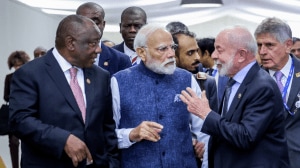An incomplete grief
Ever since their loved ones went missing during the post-Godhra riots in 2002, these families have lived their lives in waiting.

While the 17 bomb blasts on July 26, which left 49 dead and over 100 injured, are the most recent wounds to Ahmedabad’s psyche, the shadows of the 228 ‘missing’ persons from the post-Godhra riots of 2002 have left scar tissue that remains raw to this day. When nine-year-old Muzaffar was recently found alive and well almost seven years after he was wrenched away from his parents during the massacre in Ahmedabad’s Gulbarg Society on February 28, 2002, the story made national news, probably because his survival defied all odds. And even though Muzaffar’s story has taken a bittersweet turn, with him refusing to leave the Hindu foster family that took care of him ever since he was a toddler, his biological family has something that hundreds of others here crave for: an answer.
In a small two-bedroom Housing Board flat in Bapunagar, a mother can’t bear to put a picture of her missing son on the wall because then, she says, her tears won’t stop. At another smaller house nestled between office-desk-wide lanes in Rakhial, two children do not remember much about their mother but still long to have her back, even though they grew up without her. Another father still hopes that his two-year-old daughter managed to survive the rampaging mobs and will one day knock on his door.
Every day is a living hell for him, says Mebla Hussain, a lathe mechanic, whose son Mohsin was killed and two-year old daughter Aafreen went missing from Naroda Patiya on February 28, 2002. He says, “If she is dead, was she buried, is she resting in peace? If she is alive, then how is she living? This uncertainty is maddening.” Hussain who remarried two years ago and is struggling to rebuild his life has searched everywhere for his daughter. He knows his chances of finding Aafreen are slim. After all, his sister-in-law, who had been holding his daughter, hadn’t been able to survive the murderous mobs that day. “I searched for my daughter in the heap of mangled, mutilated, burnt bodies. I removed 19 children from the pile but she was not there. Who knows what happened?”
In Bapunagar, Shanta Murmiya continues to wait for the youngest of her five children. She hasn’t seen Vinod, 14 at that time, ever since he went out to play marbles with his neighbourhood gang. She still hopes he’ll come back.
“Main kaise yeh maan loon ki mera beta ghar nahin aayega? Main to yahi dua karti hoon ki wo jahan bhi ho theek se ho. Usko sirf khelne ka shauk tha, school se aa kar seedhe khelne bhaag jaata tha. Agar us din main usko nahin jaane deti… (How can I believe that my son won’t come back? I just pray for his well being, wherever he is. He used to return from school and run out with his friends. If only that day I had stopped him from going out…).”
The families of missing persons continue to exist in a bleak limbo, where there are no answers, no certainties — denied even the cold comfort of knowing that their loved ones are truly gone, their grief is incomplete, and the vestiges of hope that remain torment rather than heal.
In Ramol, Zulekha, 9, and Sameer, 7, become tense whenever there is talk of their mother, Shenaz Bano, who went missing from Shah-e-Alam relief camp in 2002. Their uncle Nizam Mohammad says, “These children still cannot understand or explain what happened to their mother. She was with them one moment and gone the other. There is no one to take care of them.”
But life goes on, and sometimes, a more fatalistic approach makes it easier to cope. Tarkas Bano in Naroda Patiya has accepted that her 70-year-old mother’s disappearance means she is dead. She says, “When they came wearing saffron headbands and faces covered with black cloth, my mother told me to take my children and run. She said no matter who they are they won’t kill an old woman. The last we heard was that they threw her from the roof of the house. We didn’t find her body.”
What then lies in store for Gujarat’s missing? Joint Commissioner of Police Ashish Bhatia, member of the Special Investigation team (SIT), says, “Of the 10 specific cases that we have been required to look into, we will do what we can. If we get specific requests or information we will act on it.” As for those who remain lost, time is running out — one more year and even the law will presume them to be dead. Yet, in the absence of answers, chances are the wait will go on forever.








- 01
- 02
- 03
- 04
- 05























